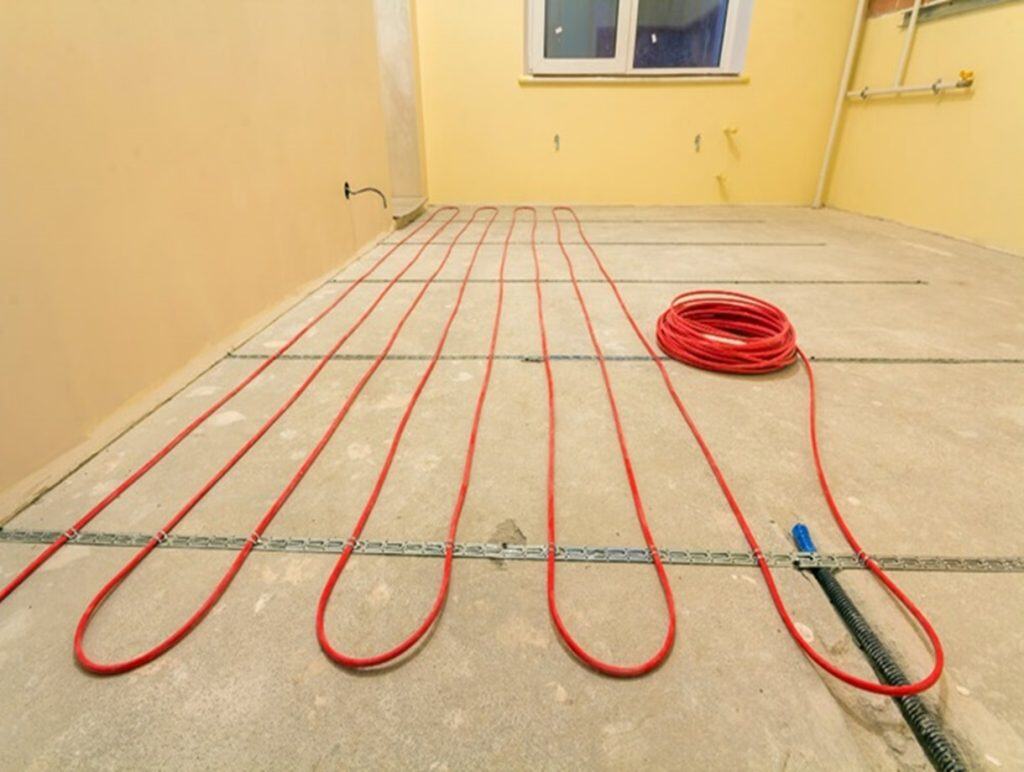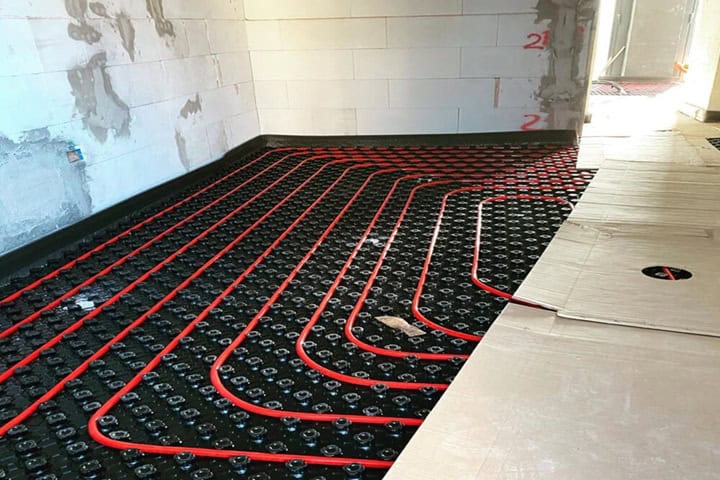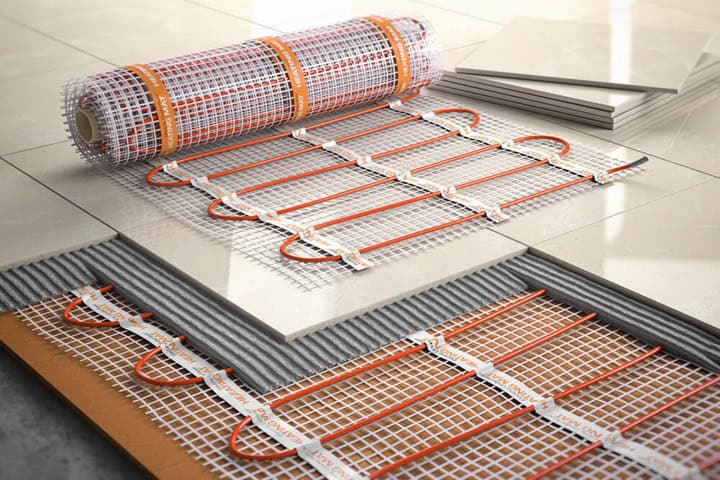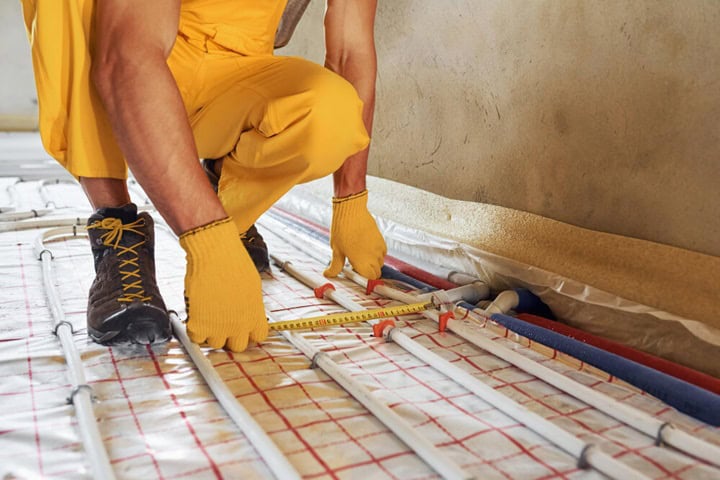
Have you heard of underfloor heating? If so, there are primarily two types for you to know about, but which is the right heating system for your home?
In contemporary central heating systems, there are many to choose from. But one that stands tall above the rest that brings not only long term benefits for you and your home, but also for your energy bills too. In this article, we will compare electric vs water underfloor heating systems to help you decide which is best for your home or renovation project. You’ll learn how each system works, how much they cost to install and run, and which one fits your home better. With that being said, let’s discover whether electric or water underfloor heating is right for you.
Key Points:
- Learn how electric and water underfloor heating systems work
- Discover which system suits new builds or retrofit projects
- Compare installation and running costs
- Understand how long each system takes to heat up
- Find out which system is more energy efficient and easier to maintain
- How Each Underfloor Heating System Works
- What Projects Are Best Suited for Each System?
- Where To Add Water Underfloor Heating
- Where To Add Electric Underfloor Heating
- How Much Does Underfloor Heating Cost to Install?
- Electric Underfloor Installation Costs
- Water Underfloor Installation Costs
- How Much Does Underfloor Heating Cost to Run?
- Electric Underfloor Running Costs
- Water Underfloor Running Costs
- What About Maintenance?
- Water Underfloor System Maintenance
- Electric Underfloor Maintenance
- Which System Is More Energy Efficient?
- Can You Repair Electric Underfloor Heating?
- How Long Does Underfloor Heating Take to Warm Up?
- Are Heat Pumps Compatible with Underfloor Heating?
- Can You Use Smart Thermostats with Underfloor Heating?
- Underfloor Heating: Water or Electric?
- FAQs
- Sources
How Each Underfloor Heating System Works
Underfloor heating works by turning the floor itself into a heat source. Instead of relying on radiators that warm a single point in the room, underfloor systems create a gentle, even warmth that rises from the ground up. No cold corners, no noisy radiators, and no bulky units getting in the way of your furniture layout.
What Is Water Underfloor Heating?

Water underfloor heating—also called hydronic or wet underfloor heating kits —uses a network of pipes laid beneath your floor. Warm water is circulated through these pipes, creating a steady and consistent heat source.
The pipework is connected to a central manifold, which manages water flow and temperature. This manifold connects to your boiler or heat pump, depending on your setup. It’s important to make sure your chosen heat source is fully compatible with a wet system, so a quick check with your installer is always worthwhile.
There are different types of water underfloor heating systems available. The most common is a screeded system, where pipes are embedded into a layer of concrete or screed. For properties with suspended timber floors, specialist systems are designed to fit between joists or battens without raising the floor level too much.
Because of the size and nature of the pipework, water systems are better suited to projects that can accommodate their depth—like new builds or major refurbishments.
For this section, learn more with these guides:
What Is Electric Underfloor Heating?

Electric underfloor heating kits use a series of heating cables or mats installed directly beneath your floor covering. These are wired into your mains supply by a qualified electrician and controlled by a thermostat. Once activated, the cables warm up, heating the surface above.
There are several types of electric systems available, including:
- Loose wire systems – ideal for awkward spaces and unusual room shapes.
- Heating mats – great for large, open rooms and faster installation.
- Foil systems – perfect for use with floating floors like laminate or engineered wood.
- Decoupling membrane systems – best for tiled floors, offering crack protection as well as heat.
One of the greatest benefits of electric underfloor heating is how thin it is—making it an excellent choice when working with limited floor height, or if you are worried about increasing floor height during renovation projects when installing underfloor heating in old houses, for example.
It’s particularly popular for renovations and retrofits where space is tight and disruption needs to be kept to a minimum.
What Projects Are Best Suited for Each System?

When deciding between electric or water underfloor heating, it helps to look at the type of property, the room size, and the scope of your project.
Where To Add Water Underfloor Heating
Wet underfloor heating is more commonly used in new build homes or extensions where the system can be built in from the beginning. It’s ideal for large floor areas and is typically used as the main heating source for the space.
Because these systems work best when embedded in a screed layer (usually 65mm–75mm), they can take up to two hours to reach the desired temperature. However, they hold heat well, and once the floor is warm, it stays that way for a long time—making them very efficient over time.
There are also thinner flow screeds and retrofit low-profile overlay wet underfloor heating options available that reduce warm-up times and floor height issues, but these can add complexity and cost.
Typical scenarios where water underfloor heating works best include:
- Underfloor heating in new builds or full refurbishments
- Large open-plan spaces
- Projects where long-term running costs are a priority
- Homes using heat pumps or renewable heating sources
Things to consider:
- Longer warm-up time
- May need a boiler upgrade or additional plumbing work
Does underfloor heating add value to your home? Discover the truth now.
Where To Add Electric Underfloor Heating
Electric underfloor heating is a go-to solution for smaller rooms and renovation projects. It’s quick to install and doesn’t require any changes to your existing boiler or plumbing setup.
Because the heating elements are slim and flexible, they’re ideal when you want to keep floor levels as close to the original as possible. That makes them perfect for bathrooms, kitchens, and conservatories.
Electric systems also heat up fast—typically within 20 to 30 minutes—especially when used with insulation boards that reduce heat loss and speed up warm-up times.
Electric underfloor heating systems are available in different wattages:
- 100W/m² – ideal for well-insulated rooms
- 150W/m² – recommended for bathrooms
- 200W/m² – best for conservatories or areas with high heat loss
Electric underfloor heating is ideal for:
- Retrofit or single-room upgrades
- Projects with limited floor height
- Homeowners wanting minimal disruption
- Spaces that don’t need full-day heating
Things to consider:
- Higher running costs if used as the main heating source
- Needs careful programming to be cost-effective
How Much Does Underfloor Heating Cost to Install?

When comparing electric or water underfloor heating and how much does underfloor heating cost per m2, the upfront cost is one of the biggest factors homeowners consider. The type of system, size of the area, and whether you’re working on a new build or renovation all impact the final price.
Electric Underfloor Installation Costs
Electric underfloor heating is generally cheaper and quicker to install. On average, it costs around £800 to fit 10m², making it a popular choice for smaller projects and individual rooms.
Because there’s no need for pipework, manifolds, or a connection to your central heating system, labour costs are usually lower. It’s also less invasive, which is why electric UFH systems are often favoured in retrofits.
Water Underfloor Installation Costs
Water underfloor heating is more expensive upfront, averaging £1,200 for a 10m² space. The additional cost comes from the pipework, screeding, manifold setup, and connection to a boiler or heat pump.
In a new build, the extra work is easier to manage, but in existing properties it may involve lifting floors or changing floor levels. That’s why wet systems are more often installed during major renovations or as part of new home construction.
How Much Does Underfloor Heating Cost to Run?
Running costs vary depending on a few key factors:
- The size of the heated space
- Energy prices (electricity vs gas)
- How well your home is insulated
- How the system is controlled
Electric Underfloor Running Costs
Electric underfloor heating can be more expensive to run, especially in larger areas. For example, a 200W/m² system will use 1kWh of electricity every 5m², which currently costs around 52p. Most people only run electric systems for 2–4 hours a day and in smaller rooms like bathrooms or kitchens. On average, a 3m² system used for four hours daily might cost around £0.70 to £1.00 per day.
Water Underfloor Running Costs
Water underfloor heating is generally cheaper to run, particularly when connected to a gas boiler or heat pump. With gas currently priced around 15p per kWh, the savings add up quickly for larger spaces. If your flow temperature is reduced with good insulation and controls for underfloor heating, you can save even more.
What About Maintenance?
Another consideration when comparing electric vs wet underfloor heating is how much upkeep each system needs.
Water Underfloor System Maintenance
Wet UFH systems don’t need much day-to-day maintenance, but you should have your boiler serviced annually, as it’s the core of the system. It’s also a good idea to check the manifold for leaks or worn valves. These checks can usually be carried out during regular boiler servicing.
Electric Underfloor Maintenance
Electric underfloor heating has no moving parts, so there’s nothing to service. However, it’s important to test the system at three key stages during installation to ensure the cable hasn’t been damaged. This also helps protect your warranty.
Which System Is More Energy Efficient?
Both systems are more efficient than traditional radiators because they spread heat evenly across the whole floor at a lower temperature.
- Electric UFH: Is 100% efficient at point of use. This means that every unit of electricity used is turned directly into heat under the floor—no energy is lost in transit.
- Water UFH: Water systems are still highly efficient but lose between 20%–40% of heat through pipework and the boiler system. However, they work at lower temperatures than radiators and tend to hold heat for longer, especially when embedded in screed.
When deciding between underfloor heating water or electric, consider your long-term energy usage. For large areas, a water system connected to a heat pump or efficient boiler usually makes more sense. For smaller rooms or occasional heating, electric systems are often more practical.
Can You Repair Electric Underfloor Heating?

Electric underfloor heating systems are generally reliable and low-maintenance, but faults can occasionally occur—especially if the cable is accidentally damaged during installation. The good news is that these systems can usually be repaired without replacing the whole setup. Read more in our repairing underfloor heating guide.
Most UFH systems come with a lifetime warranty if properly installed and tested. If a fault does occur, thermal imaging or resistance testing can pinpoint the damaged area. While not completely hassle-free, repairs are typically straightforward and localised – contact us today and see how our team can help.
How Long Does Underfloor Heating Take to Warm Up?
Unlike radiators, underfloor heating warms the floor first before the room itself, so it’s a bit slower to get going. But once it reaches temperature, the heat is more even and longer lasting.
Electric UFH can warm up quicker —usually between 20 to 40 minutes, depending on the output level and insulation. This makes it ideal for rooms you only use at certain times of the day, like en-suites or kitchens.
Wet UFH take longer to warm up—often 1 to 2 hours—especially when installed within a screeded floor. However, they retain heat well, meaning the warmth lasts longer after the system is turned off. This makes them more suited to spaces where continuous heating is needed.
Flooring also plays a role. Materials like porcelain or ceramic tiles, stone, and engineered wood have good thermal conductivity and work well with both systems. Thicker materials (such as natural stone) will take longer to heat up but hold the warmth more effectively.
Are Heat Pumps Compatible with Underfloor Heating?
Yes—and they’re actually a great match. If you’re deciding between underfloor heating water or electric systems and you’re already using a heat pump or planning to install one, a wet system is likely the better option.
Heat pumps produce water at lower temperatures, which is perfect for water underfloor heating. This pairing improves overall energy efficiency and keeps running costs down. It also reduces the carbon footprint compared to traditional gas boilers. So if you’re aiming for a more energy-conscious setup, water underfloor heating with a heat pump is worth considering.
Understand more in these guides:
Can You Use Smart Thermostats with Underfloor Heating?
Whether you choose electric or water underfloor heating, both systems can work with smart controls—though the setup is slightly different.
For water systems, most smart thermostats can control the boiler, turning the system on and off as needed. If your home is zoned, some systems allow you to control each zone individually using a smart manifold.
For electric systems, you’ll need a thermostat that can control an electric circuit. Some systems come with their own smart-compatible controllers, or you can opt for third-party ones designed for electric heating.
Smart controls not only improve comfort but can help lower running costs by avoiding unnecessary heating. Many can learn your schedule and preheat rooms only when needed.
Underfloor Heating: Water or Electric?
So, in conclusion, when it comes to electric or water underfloor heating, which one is right for you?
It depends on your space, budget, and long-term plans. Whether you’re installing underfloor heating water or electric, make sure to factor in running costs, floor types, and whether smart controls or renewable energy sources will be used. That way, you’ll get a system that’s not only comfortable but cost-effective too. Next, learn which is the best underfloor heating system.
FAQs
Is underfloor heating safe for pets and children?
Absolutely. Underfloor heating provides a safe, low-surface-temperature heating method. Unlike radiators, there are no hot surfaces or sharp edges. It’s ideal for households with young children or pets who play or rest on the floor.
Can you install underfloor heating upstairs?
Yes. Water and electric systems can be installed on upper floors. Lightweight systems or low-profile retrofit solutions are ideal to avoid adding significant weight or height to the floor structure.
What flooring works best with underfloor heating?
Flooring with high thermal conductivity works best. Tiles, stone, and engineered wood are excellent choices. Carpet and laminate can also work but should be under specific thickness and tog limits to allow efficient heat transfer.
Sources
Carr, P., (2024) Getting your boiler serviced. Money Super Market. [online] Available at: https://www.moneysupermarket.com/boiler-cover/boiler-service/ [accessed 19/05/2025]
